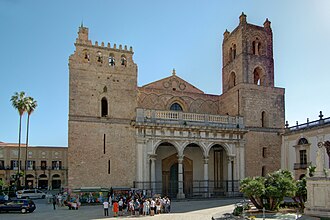Archdiocese of Monreale Archidioecesis Montis Regalis | |
|---|---|
 Monreale Cathedral | |
| Location | |
| Country | Italy |
| Ecclesiastical province | Palermo |
| Statistics | |
| Area | 1,509 km2 (583 sq mi) |
Population
|
|
| Parishes | 69 |
| Information | |
| Denomination | Catholic Church |
| Rite | Roman Rite |
| Established | 1176 (848–849 years ago) |
| Cathedral | Basilica Cattedrale di S. Maria La Nuova |
| Secular priests | 110 (diocesan) 26 (Religious Orders) 11 Permanent Deacons |
| Current leadership | |
| Pope | Leo XIV |
| Archbishop | Gualtiero Isacchi |
| Bishops emeritus | Michele Pennisi Salvatore Di Cristina |
| Map | |
 | |
| Website | |
| www.diocesimonreale.it | |
The Archdiocese of Monreale (Latin : Archidioecesis Montis Regalis) is a Latin archdiocese of the Catholic Church in Sicily. As of 2000 it is no longer a metropolitan see, and is now a suffragan of the Archdiocese of Palermo. [1] [2]
